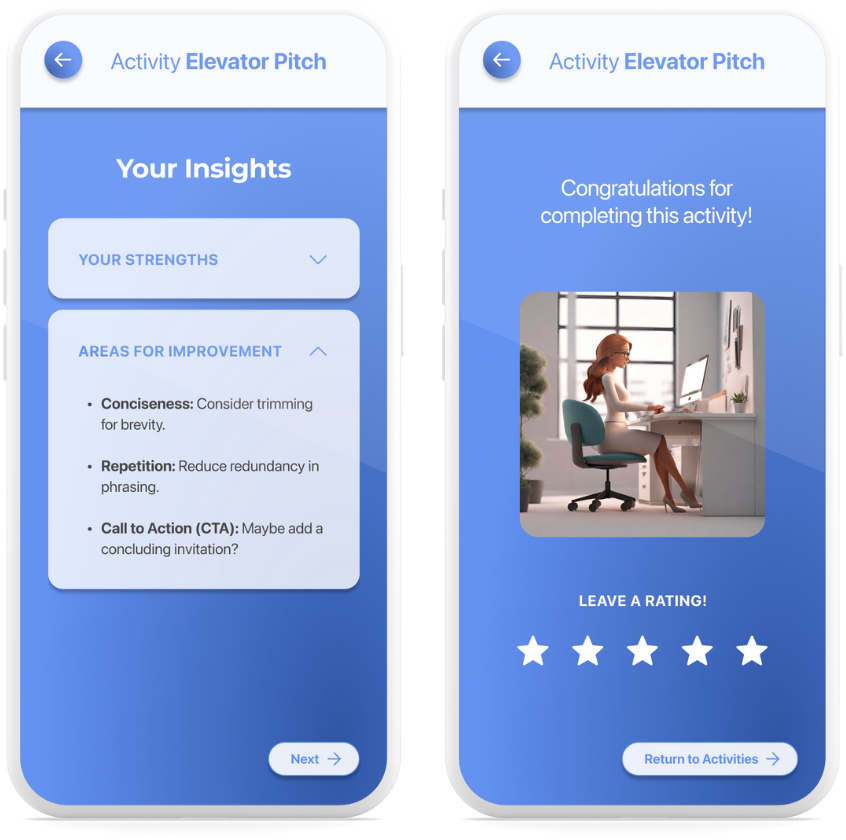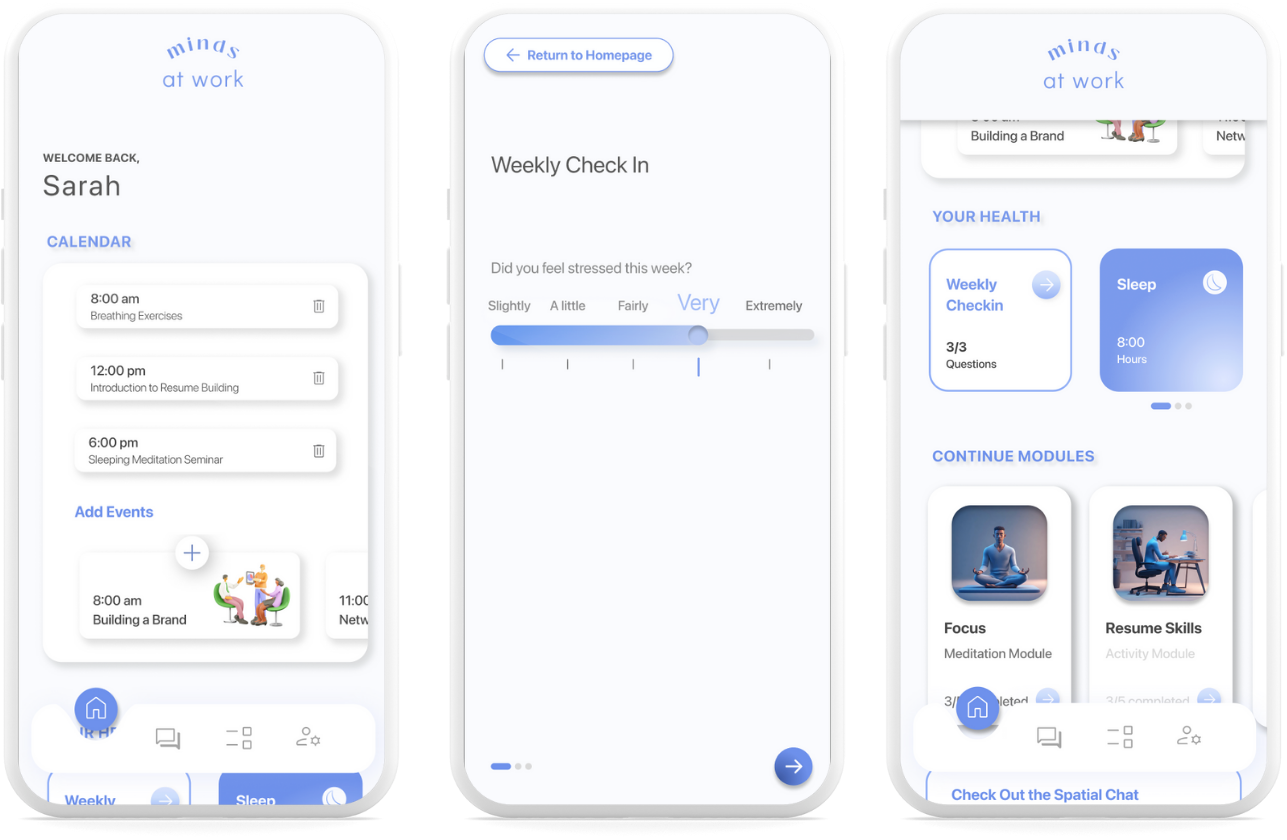
Minds at Work
Project Overview
In Semester 2 of 2023, I took Interaction Design Studio (DECO2014) as part of my Interaction Design Degree. This project followed an iterative double diamond approach, beginning by understanding our target users to grasp their daily experiences on university campuses. These insights were then used to frame our idea development process.
Structure
Individual (initial research and ideation)
Group task beginning from user-research of problem area to execution of high-fidelity prototype and presentation of solution.
Team: Arisha, Serena, Somya
Timeframe
August - November 2023 (3 months)
Tools
Figma
Procreate
Adobe After Effects
Canva

AI Chat Bot

Activity Prompts Page

Completing an Activity Prompt

AI Generated Insights

Spatial Learning Hub

Chat Room

Personalised Dashboard
Problem Area
In today's rapidly growing professional landscape, the journey of transitioning into employment has become increasingly complex for first-time work entrants. The competitive job market can lead to uncertainty, job dissatisfaction, and even burnout, which can have a detrimental impact on the mental and emotional well-being of first-time work entrants (Veylan, n.d.).
Conducting Primary Research to understand key user needs
Testing Methodology: Online ethnography, Interviews, questionnaires.
Our investigation focused on understanding the root causes of their stress, the reasons behind their feelings, and the effectiveness of existing support mechanisms. Through a methodical approach, we integrated data from questionnaires, semi-structured interviews, and online ethnography to derive comprehensive insights into user experiences.
Data Analysis and Synthesis Methodologies: Affinity Diagramming, Insight Tables, User Persona, Storyboarding, User-Journey Mapping.
Our affinity diagram,pinpointed five primary challenges: work-life balance, inadequate job-seeking support, workplace conflicts, job seeker stress, and societal expectations on young adults. Using a insights table further helped us measure the severity of user needs and uncover additional usability goals that were essential for a seamless user interaction, even if they weren't initially in the test plan. Leveraging these insights, we developed 3 user personas with corresponding storyboards and user-journey. Each addressing the identified challenges, underscoring the critical need for solutions that enhance well-being and career satisfaction.
By thoroughly analysing and synthesising our data, we refined our problem statement to:
"Addressing The Psychological Struggles of Inexperienced Workforce Entrants in Australia."
How we came up with our concept
We began with 3 concepts which arose through using various ideation concepts. We then created and used a decision matrix to justify the best idea, based off a series of metrics developed in consideration of the user needs as well as assignment brief.
Reverse Thinking
-
Integrated platform enabling university students to juggle University commitments with Job seeking deadlines.
-
Immersive Virtual Reality (VR) experience which mirrors real-world experiences involved in entering the workforce for the first time.
S.C.A.M.P.E.R
-
Platform enabling both Job-Seekers and New-Recruits to gain fundamental experiences involved in both of these processes
Crazy Eight’s
“Minds at Work” best fulfilled the targets of our decision matrix scoring 221.
We also considered potential ethical concerns…
When finalising our concept, it was important to understand the global audience this will be made for and our responsibility to keep their wellbeing at the forefront of the app.
Potential ethical concerns:
Overcommitment to the app may lead to time management issues and cause additional stress as the user may neglect their personal life and leisure.
Group conflicts could arise since the app primarily focuses on individual progress, and can promote habits that don’t align with work environments.
Potential Solutions:
Low Fidelity: Initial Sketching and mapping out the user flow end-to-end
Transferring the final concept to paper enabled enhanced communication of the idea during peer-review stages. Having a visual representation facilitated a more thorough investigation and critique of the idea, simplifying the identification of possible drawbacks and areas for enhancement.
Prototyping iteratively through 5 iterations and 2 rounds of testing
Testing the Wireframes
Mid Fidelity: Wireframing and mapping out user flows in greater depth
Transferring the initial sketch into wireframes on Figma enabled a focused examination of the fundamental page layout and application architecture, setting a solid foundation before moving into high-fidelity protoyping. This method supports a structured approach to design, allowing for an efficient review and refinement of the core user experience before advancing to aesthetic and functional enhancements.
Testing the Wireframes
Testing Methodology: We adopted a hybrid approach, encompassing Peer Evaluations, Expert Testing (Cognitive Walkthrough), and User Testing (Think-Aloud).
Analysis and Synthesis: We systematically reviewed the data, gaining a comprehensive understanding of both positive and negative feedback across the system to identify common user perceptions and significant usability issues.
Affinity Diagramming for each feature:
Key Insights:
High Fidelity: Mockups
Three iterations occurred in the development of the high-fidelity prototype, guided by the Sequential Testing Plan. We have employed a Sequential Testing Plan beginning with tutor feedback, Expert Testing (Heuristic Evaluations) and finally User Testing (First Click Test, Think Aloud, and SUS Survey). Insights were meticulously assessed and organised into an Insights Table at each stage of the testing plan informing the each iteration.
Key Iteration: Academic advice directed to enhance our interface's effectiveness by increasing contrast and visibility, thereby ensuring a more responsive and effective system interaction upon activation. We addressed issues related to the logo, which was initially represented by thin lines that cluttered the space. We opted for bolder fonts and text-only representation, ensuring users easily grasp the loading screen's purpose without overlooking essential information
Mockup: Iteration 1
Mockup: Iteration 3
Key Iteration: In response to feedback from user testing, we recognised that users were experiencing difficulty with horizontal navigation across screens, particularly when attempting to locate Table 5. To address this issue and enhance learnability, we introduced clear swipe left and right icons accompanied by subtle animations to intuitively guide users through the correct swiping action, making the navigation process more user-friendly and efficient (Laubheimer, 2020).
Mockup: Iteration 2
Key Iteration: In response to heuristic testing outcomes, safety, security and privacy concerns were addressed by implementing a pop-up that requests microphone access permissions before a user joins a room, thereby ensuring that users are aware of and can control their privacy settings (Rosala, 2019).
In our first-click user-testing 2/3 people failed to return to the spatial chat home
“The tables don’t look look clickable” - tutor feedback
“like, if I press it, it will record me, but, like, not in the way that I thought it would.” - User testing participant
Presenting the Final Solution
"Minds at Work" is a versatile and interactive platform available on mobile, desktop, and smartwatch devices, tailored for individuals seeking employment or requiring support throughout the onboarding phase.
This application offers a suite of features designed to enhance users' skill sets and deepen their understanding of their professional field. With a comprehensive and engaging welcome experience for newcomers, complete with a detailed onboarding guide, "Minds at Work" incorporates an AI-powered mentor, interactive tasks, a captivating spatial learning environment, and a diverse collection of meditations.
Filmed with iPhone. Edited with Adobe After Effects, Canva Video.
5.0 What did I learn?
Serena Huang
Developing a design solution from inception to completion was a challenging yet immensely fulfilling journey alongside my passionate team. This experience not only honed my creative and problem-solving abilities but also provided me with a unique opportunity to tackle underrecoginsed concerns, particularly from the perspective of a university student looking to enter the professional workforce full-time. My extensive research into the challenges faced by inexperienced workforce entrants in Australia underscored the critical importance of prioritising wellbeing during this pivotal stage of life. It displays how thoughtful design can effectively meet the needs of individuals navigating this significant transition, affirming the role of design in facilitating positive change.














